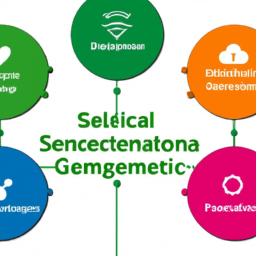Are you looking to take your career to the next level?
Have you ever wondered how you can enhance your problem-solving skills and make data-driven decisions?
Well, becoming a Six Sigma Green Belt might be the answer you’ve been searching for.
With this prestigious certification, you’ll not only open up a world of increased career opportunities but also streamline processes, reduce costs, and boost team collaboration.
Get ready to dive into a continuous improvement culture that will transform your professional life.
Key Takeaways
- Increased job stability and value to employers
- Improved problem-solving skills and critical thinking abilities
- Enhanced quality control and process improvement capabilities
- Cost reduction and efficiency optimization opportunities
Increased Career Opportunities
Becoming a six sigma green belt opens up more career opportunities for you. By obtaining this certification, you increase your job stability, as companies value employees who possess the knowledge and skills to improve processes and reduce defects.
With a green belt, you become an asset to organizations looking to streamline their operations and improve efficiency. This certification also contributes to your professional growth and development. It equips you with the tools and techniques to identify and solve problems, analyze data, and make data-driven decisions.
These skills are highly sought after in various industries, allowing you to explore new job roles and take on more challenging projects. As you enhance your problem-solving skills, you become even more valuable to employers, ensuring continued career growth and advancement opportunities.
Enhanced Problem-Solving Skills
Improve your problem-solving skills with the enhanced abilities gained from earning a Six Sigma Green Belt.
By acquiring this certification, you will develop improved problem-solving techniques and a critical thinking enhancement that can be applied in various professional settings.
The Six Sigma methodology focuses on reducing defects and improving quality by utilizing data-driven analysis and statistical tools.
As a Six Sigma Green Belt, you will learn to identify and analyze problems systematically, use data to make informed decisions, and implement effective solutions.
This certification equips you with the skills necessary to tackle complex problems, optimize processes, and drive continuous improvement within organizations.
Your ability to apply data-driven problem-solving methods will make you a valuable asset in any industry, as you contribute to improving efficiency, reducing costs, and enhancing overall performance.
Improved Quality Control
By earning the Six Sigma Green Belt certification, you’ll gain the skills necessary to effectively implement quality control measures in your organization. This certification equips you with the knowledge and tools to drive quality improvement and waste reduction.
With improved quality control, you’ll be able to identify and eliminate defects, ensuring that your products and services meet or exceed customer expectations.
Here’s an imagery of the benefits you’ll experience:
-
Enhanced efficiency:
-
Streamlined processes that reduce waste and increase productivity
-
Improved cycle times, allowing for faster delivery of products or services
-
Enhanced customer satisfaction:
-
Consistently delivering high-quality products or services that meet customer needs and expectations
-
Minimized customer complaints through proactive quality control measures
Streamlined Processes
When it comes to reducing operational inefficiencies and improving quality control, becoming a six sigma green belt can provide powerful benefits.
By streamlining processes, you can identify and eliminate waste, saving time and resources.
This data-driven approach allows you to analyze and improve the overall efficiency and quality of your operations, leading to increased productivity and customer satisfaction.
Reduced Operational Inefficiencies
Reduced operational inefficiencies can lead to significant cost savings for organizations that invest in six sigma green belt training. By implementing the principles of six sigma, organizations can achieve a streamlined and efficient workflow, resulting in reduced waste and improved resource allocation.
Here are two sub-lists that illustrate the impact of reduced operational inefficiencies:
-
Reduced Waste:
-
Elimination of unnecessary steps in processes
-
Minimization of defects and errors through improved quality control
-
Improved Resource Allocation:
-
Optimal utilization of manpower and equipment
-
Efficient allocation of time and materials
Improved Quality Control
To improve quality control, you can implement effective measures to identify and minimize defects in your processes. By doing so, you can achieve improved product performance and better supply chain management.
One way to achieve this is by conducting thorough inspections and tests at various stages of production. This allows you to catch any issues early on and prevent them from escalating into costly defects.
Additionally, implementing robust quality control systems and procedures can help you track and analyze data to identify patterns and root causes of defects. By using data-driven insights, you can make informed decisions to address any underlying issues and continuously improve your processes.
This focus on quality control not only ensures that your products meet or exceed customer expectations but also helps you establish a reputation for reliability and customer satisfaction.
Cost Reduction
In this discussion, you will explore the key points of operational efficiency through cost reduction and increased profitability through cost reduction.
By implementing cost reduction measures, you can optimize your operations and improve overall efficiency, leading to reduced expenses and resource wastage.
Furthermore, a focus on cost reduction can also directly impact your profitability, as it allows you to maximize profits by minimizing costs and increasing your bottom line.
Operational Efficiency Through Cost Reduction
Maximize your operational efficiency by leveraging cost reduction strategies as a Six Sigma Green Belt. As a Six Sigma Green Belt, you possess the skills and knowledge to optimize your organization’s processes, ensuring operational effectiveness. Here’s how you can achieve operational efficiency through cost reduction:
-
Identify and eliminate wasteful activities: By analyzing processes and identifying non-value-added steps, you can streamline operations and reduce costs.
-
Implement process optimization techniques: Utilize Six Sigma tools such as DMAIC (Define, Measure, Analyze, Improve, Control) to identify and eliminate process inefficiencies and bottlenecks.
Increased Profitability Through Cost Reduction
By leveraging cost reduction strategies, you can boost profitability through increased efficiency. Implementing cost reduction measures allows you to identify and eliminate unnecessary expenses, ultimately leading to increased profitability.
One effective strategy is optimizing your supply chain by negotiating better prices with suppliers and streamlining the procurement process. Another approach is to identify and eliminate waste in your operations through lean manufacturing principles. By reducing waste, such as excess inventory or inefficient processes, you can significantly decrease costs and improve your bottom line.
Additionally, investing in technology and automation can help improve productivity and reduce labor costs. By continuously monitoring and analyzing your expenses, you can identify areas for cost reduction and implement strategies that will contribute to increased profitability.
Transitioning to the next section, increased profitability can also lead to enhanced customer satisfaction.
Increased Customer Satisfaction
Becoming a six sigma green belt can enhance your customer satisfaction in several ways. Firstly, you’ll experience a significant boost in customer satisfaction as a result of this certification. This is because it enables you to improve service delivery and gain a competitive advantage in the market.
One way in which becoming a six sigma green belt can enhance customer satisfaction is through streamlined processes. By analyzing data and identifying areas for improvement, you’ll be able to streamline processes, reducing errors and delays. This leads to faster and more efficient service delivery, satisfying your customers’ needs promptly.
Another way in which customer satisfaction can be enhanced is through enhanced quality control. As a six sigma green belt, you’ll have the skills to monitor and control quality at every stage of the process. By ensuring consistent quality, you’ll provide customers with products or services that meet or exceed their expectations.
Boosted Team Collaboration
Working together as a team, you can achieve greater collaboration and synergy, leading to improved efficiency and productivity. Collaborative problem solving allows team members to pool their unique perspectives and expertise, resulting in more effective solutions. By leveraging the strengths of each individual, you can tap into the power of team synergy, where the whole becomes greater than the sum of its parts.
This collaborative approach fosters innovation and creativity, as diverse ideas are shared and explored. Additionally, team collaboration enhances communication and coordination, reducing errors and rework. Studies have shown that teams who effectively collaborate are more likely to achieve their goals, meet deadlines, and produce higher quality work.
Data-Driven Decision Making
Using data to inform decision making allows teams to make informed choices based on objective information and analysis. This data-driven approach ensures that decisions are not based on gut feelings or personal biases, but rather on concrete evidence and statistical methods. By utilizing data analysis techniques, teams can uncover valuable insights and patterns that may otherwise go unnoticed.
To paint a picture in your mind, imagine a team pouring over spreadsheets and charts, meticulously examining each data point to identify trends and correlations. They use statistical methods to analyze the data, such as regression analysis or hypothesis testing, to draw meaningful conclusions. Armed with this knowledge, the team can confidently make data-driven decisions that have a higher chance of success.
Effective Change Management
Change management is essential for organizations to successfully navigate and adapt to new processes and systems. Effective change management strategies are crucial in ensuring smooth transitions and minimizing disruptions.
One key aspect of successful change management is effective communication. When implementing changes, it’s important to clearly communicate the reasons, benefits, and expectations to all stakeholders. This helps to create a shared understanding and commitment to the change. Effective communication also involves regular updates and feedback loops to address any concerns or issues that may arise.
By incorporating data-driven decision making into change management, organizations can gather and analyze relevant information to support their strategies. This enables them to make informed decisions and identify potential risks or opportunities.
Overall, effective change management, supported by clear communication and data-driven decision making, is vital for organizations to adapt and thrive in today’s rapidly changing business environment.
Continuous Improvement Culture
In order to create a continuous improvement culture within your organization, it’s essential to focus on creating a positive workplace environment. This has been proven to have a significant impact on employee motivation and engagement.
A positive workplace environment not only boosts morale but also leads to increased productivity and efficiency among employees. This allows them to perform at their best.
Moreover, a continuous improvement culture fosters enhanced problem-solving skills among employees. They are encouraged to constantly seek out opportunities for improvement and innovation.
Positive Workplace Environment
To create a positive workplace environment, you’ll need to foster open communication and collaboration among team members. This is crucial for building positive workplace relationships and promoting employee engagement.
Here are two ways you can achieve this:
-
Encourage regular team meetings where everyone has an opportunity to share their ideas, concerns, and suggestions. This will create a sense of belonging and encourage active participation.
-
Implement team-building activities that promote collaboration and trust. This could include group projects, team outings, or even simple icebreaker activities to break down barriers and foster stronger relationships.
Increased Productivity and Efficiency
By fostering a positive workplace environment, you can boost employee engagement and productivity.
Increased employee engagement has been proven to have a direct impact on the overall efficiency and effectiveness of an organization. Studies have shown that engaged employees are more motivated, committed, and focused on their work. This leads to improved decision-making processes within the company.
When employees are engaged, they are more likely to actively participate in problem-solving discussions and contribute innovative ideas. This collaborative approach to decision-making results in better outcomes and increased efficiency.
Furthermore, engaged employees are also more likely to be proactive, taking initiatives and finding ways to improve processes and streamline operations.
Enhanced Problem-Solving Skills
Now that you understand how becoming a Six Sigma Green Belt can increase productivity and efficiency, let’s delve into another powerful benefit: enhanced problem-solving skills.
As a Six Sigma Green Belt, you will develop a strong aptitude for critical thinking and problem-solving techniques. Here are two ways in which your problem-solving skills will be improved:
-
Data-driven approach: You will learn to analyze data effectively and make informed decisions based on statistical analysis. This data-driven approach will enable you to identify root causes of problems and develop effective solutions.
-
Structured problem-solving methods: You will be equipped with various problem-solving methodologies such as DMAIC (Define, Measure, Analyze, Improve, Control) and PDCA (Plan, Do, Check, Act). These structured methods will guide you through the problem-solving process, ensuring that you approach problems systematically and efficiently.
Frequently Asked Questions
How Long Does It Take to Become a Six Sigma Green Belt?
To become a Six Sigma Green Belt, it typically takes around 2 to 3 months of training and preparation. This involves learning the principles and methodologies of Six Sigma, as well as passing an examination.
Obtaining this certification can bring a range of benefits, such as improved problem-solving skills, increased job opportunities, and enhanced career growth.
The rigorous training process ensures that Green Belts are equipped with the necessary skills to drive process improvements and contribute to organizational success.
What Is the Difference Between a Six Sigma Green Belt and a Six Sigma Black Belt?
The difference between a Six Sigma Green Belt and a Six Sigma Black Belt lies in the level of expertise and responsibility.
As a Green Belt, you will learn the foundational concepts and tools of Six Sigma and work on smaller, focused projects. This certification level provides a solid understanding of process improvement and prepares you to support larger projects led by Black Belts.
The benefits of becoming a Six Sigma Green Belt include increased job opportunities, improved problem-solving skills, and the ability to drive significant improvements in business processes.
Are There Any Prerequisites or Qualifications Required to Become a Six Sigma Green Belt?
Before we dive into the amazing benefits of becoming a Six Sigma Green Belt, let’s address the question of prerequisites and qualifications.
The good news is that there are no specific prerequisites to become a Green Belt. However, having a basic understanding of statistics and problem-solving skills will definitely give you an edge.
Can Six Sigma Green Belt Certification Be Obtained Online or Is It Only Available Through In-Person Training?
Whether you choose online or in-person training for Six Sigma Green Belt certification, both options have their own merits.
Online training offers convenience and flexibility, allowing you to learn at your own pace.
On the other hand, in-person training provides a more interactive and hands-on experience, with the opportunity to engage with instructors and fellow participants.
Ultimately, the decision should be based on your personal learning style and preferences.
Both options can lead to valuable knowledge and skills in Six Sigma methodology.
Are There Any Industries or Sectors Where Being a Six Sigma Green Belt Is Particularly Valued or in Demand?
In industries valued for efficiency and quality, being a Six Sigma Green Belt is in high demand. Companies across various sectors recognize the value of Six Sigma methodology in reducing defects, improving processes, and enhancing customer satisfaction.
With a Six Sigma Green Belt certification, you’ll have a competitive edge and be sought after in industries such as manufacturing, healthcare, finance, and technology. Your skills and expertise in process improvement will be highly valued, opening up numerous opportunities for advancement in your chosen field.
Conclusion
In conclusion, becoming a Six Sigma Green Belt can be a game-changer for your career. The benefits are immense, ranging from increased job opportunities to enhanced problem-solving skills.
By streamlining processes and implementing data-driven decision-making, you can improve quality control and reduce costs. The impact of Six Sigma is like a laser beam, cutting through inefficiencies and fostering a culture of continuous improvement.
So, why wait? Take the leap and become a Green Belt to unlock your full potential and propel your career to new heights.

















